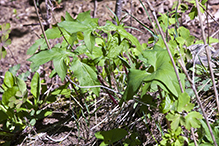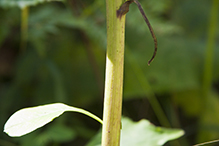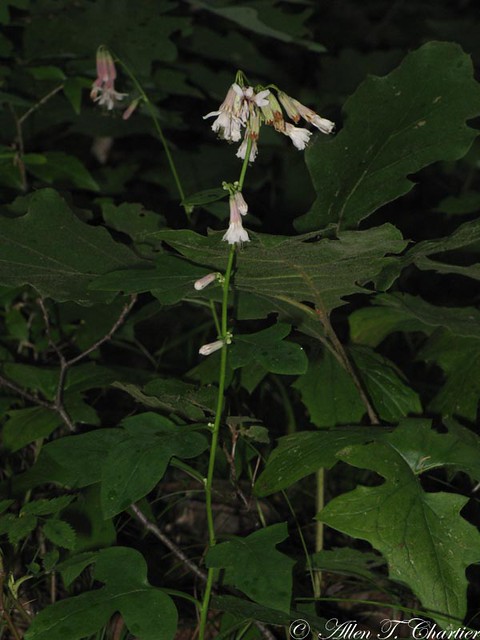white rattlesnake root
(Nabalus albus)
Conservation • Wetland • Description • Habitat • Ecology • Use • Distribution • Taxonomy
Description |
||
White rattlesnake root is a 16″ to 67″ tall, erect, perennial forb that rises on usually a single stem from a taproot. The stems are stout, erect, and sometimes branched near the top. They are light green and often mottled with purple, sometimes almost completely purple. They are hairless toward the base and inconspicuously, slightly hairy toward the tip with short, soft, curled hairs. They are often somewhat covered with a whitish, waxy bloom (glaucous). Basal and lower stem leaves leaves are highly variable in shape. Each basal leaf is on leaf stalk (petiole) up to 7″ long. The petiole is hairy and often purple. It is not winged. The leaf blade is usually triangular-shaped, 1½″ to 11¾″ long, and 1¼″ to 7″ wide. It is sometimes arrow-shaped, with a pair of outward-turned basal lobes. It is sometimes deeply cut into three lobes, sometimes divided into three leaflets. The upper surface is hairless. The lower surface is sparsely covered with short, curled hairs, and is often somewhat glaucous. The margin has a few outward-pointed teeth. Basal leaves are present at flowering time. Stem leaves are alternate. Lower stem leaves are on narrowly-winged petioles up to 7″ long. The petiole is shorter than or equal in length to the leaf blade. There is no large, leaf-like appendage (stipule) at the base of the petiole. The leaf blade is 1½″ to 11¾″ long, 1¼″ to 7″ wide, and highly variable in shape. It may be triangular, arrow-shaped, divided into 3 or 5 lobes, or egg-shaped. Leaves become progressively smaller, less divided, and on shorter petioles as they ascend the stem. The uppermost leaves may be stalkless, undivided, and untoothed. The upper surface is hairless. The lower surface is sparsely covered with short, curled hairs, and is often somewhat glaucous. When torn, the leaves exude a milky latex. The inflorescence is a branched array (panicle) at the end of the stem and branches. The panicle has 2 to 4 long branches, each with a drooping cluster of 3 to 8 flower heads. The flower heads are clustered at the branch tip. Each flower head is about ¾″ long and ½″ wide. At the base of the flower head is an involucre composed of an inner and an outer series of leaf-like appendages (bracts). The involucre is cylinder-shaped to bell-shaped, ½″ to ⅝″ long, and ⅛″ to 3 ⁄16″ wide. There are 6 to 9, usually 8, inner bracts. The inner bracts are purplish or maroon, narrowly oblong lance-shaped, ¼″ to ⅜″ long, and hairless. They are somewhat curved inward at the tip. The outer surface is whitish in appearance due to a dense covering of minute, nipple-like projections (papillae). Individual papillae can be distinguished with a 10-power hand lens. The papillae are white and appear to be covered with a waxy coating. The outer series of involucral bracts is much shorter than the inner series. There are 5 to 7 outer bracts. They are green, sometimes tinged with purple or maroon, triangular-shaped, and hairless. There are 7 to 13, usually no more than 9, ray florets and no disk florets. The ray florets are white, sometimes tinged with pink, lavender or red near the base, and ⅜″ to ⅝″ long. The fruit is a brown or tan, ⅛″ to ¼″ long achene (cypsela) with a tuft of feather-like hairs (pappus) attached to one end. The pappus is usually reddish-brown. |
||
Height |
||
16″ to 67″ |
||
Flower Color |
||
White to pale pink or lavender |
||
Similar Species |
||
Purple rattlesnake root (Nabalus racemosus) involucre bracts are hairy. White-flowered leaf-cup (Polymnia canadensis) leaves are similar, but the petioles are not winged. The larger leaves have a large, rounded stipule at the base of the petiole that surrounds the stem. The lowest pair of lobes on pinnately-divided leaves is much reduced and is separated from the adjacent pair of lobes by a short section of winged leaf stalk. |
||
Habitat |
||
Dry. Woods, deciduous forests. Partial sun or light shade. |
||
Ecology |
||
Flowering |
||
August to September |
||
Pests and Diseases |
||
|
||
Use |
||
|
||
Distribution |
||||
|
Sources |
|||
| 6/2/2023 | ||||
Nativity |
||||
Native |
||||
Occurrence |
||||
Common |
||||
Taxonomy |
|||
Kingdom |
|||
| Phylum |
Tracheophyta (Vascular Plants) |
||
Subdivision |
Spermatophytina (Seed Plants) |
||
Class |
|||
Order |
Asterales (Sunflowers, Bellflowers, Fanflowers, and Allies) |
||
Family |
Asteraceae (Sunflowers, Daisies, Asters, and Allies) |
||
Subfamily |
Cichorioideae (chicories, dandelions, and allies) |
||
Tribe |
Cichorieae (lettuce, chicory, dandelion, and salsify) |
||
Subtribe |
Crepidinae (dandelions, hawksbeards, and rattlesnake roots) |
||
| Genus | Nabalus (rattlesnake roots) | ||
This species was formerly classified as Prenanthes alba. In 2010, based on their close relationship with lettuce (Lactuca sativa), 24 species in the genus Prenanthes were moved to the genus Nabalus. |
|||
Subordinate Taxa |
|||
|
|||
Synonyms |
|||
Prenanthes alba Prenanthes alba var. alba Prenanthes alba var. pallida |
|||
Common Names |
|||
rattlesnake-root white-lettuce white rattlesnake root white rattlesnakeroot white rattlesnake-root |
|||
Glossary
Achene
A dry, one-chambered, single-seeded seed capsule, formed from a single carpel, with the seed attached to the membranous outer layer (wall) only by the seed stalk; the wall, formed entirely from the wall of the superior ovary, does not split open at maturity, but relies on decay or predation to release the contents.
Bract
Modified leaf at the base of a flower stalk, flower cluster, or inflorescence.
Cypsela
A dry, one-chambered, single-seeded fruit, formed from a single carpel, with the seed attached to the membranous outer layer (wall) only by the seed stalk; the wall, formed from the wall of the inferior ovary and also from other tissues derived from the receptacle or hypanthium, does not split open at maturity, but relies on decay or predation to release the contents.
Glaucous
Pale green or bluish gray due to a whitish, powdery or waxy film, as on a plum or a grape.
Involucre
A whorl of bracts beneath or surrounding a flower, flower head, or flower cluster.
Panicle
A pyramidal inflorescence with a main stem and branches. Flowers on the lower, longer branches mature earlier than those on the shorter, upper ones.
Papilla
On plants: A tiny, rounded, nipple-like projection on the surface of a leaf or petal. On mushrooms: A small, raised, sharply pointed projection on the cap above the point of attachment with the stalk.
Pappus
The modified calyx composed of awns, scales, bristles, or feather-like hairs in plants of the Aster family.
Petiole
The stalk of a leaf blade or compound leaf that attaches the leaf blade to the stem.
Stipule
A small, leaf-like, scale-like, glandular, or rarely spiny appendage found at the base of a leaf stalk, usually occurring in pairs and usually dropping soon.
Winged leaf stalk
A leaf stalk with a leaf-like or membrane-like extension along both sides.
Visitor Photos |
|||||
Share your photo of this plant. |
|||||
| This button not working for you? Simply email us at info@MinnesotaSeasons.com. Attach one or more photos and, if you like, a caption. |
|||||
|
|||||
MinnesotaSeasons.com Photos |
|||||
Plant |
|||||
 |
 |
||||
 |
|||||
Inflorescence |
|||||
 |
 |
||||
 |
|||||
Flowers |
|||||
 |
 |
||||
Buds |
|||||
 |
|||||
Basal Leaves |
|||||
 |
 |
||||
 |
 |
||||
Lower Stem Leaves |
|||||
 |
 |
||||
Upper Stem Leaves |
|||||
 |
 |
||||
Stem |
|||||
 |
|||||

Visitor Videos |
|||
Share your video of this plant. |
|||
| This button not working for you? Simply email us at info@MinnesotaSeasons.com. Attach a video, a YouTube link, or a cloud storage link. |
|||
Other Videos |
|||

Visitor Sightings |
|||||
Report a sighting of this plant. |
|||||
| This button not working for you? Simply email us at info@MinnesotaSeasons.com. Be sure to include a location. |
|||||
|
|||||
MinnesotaSeasons.com Sightings |
|||||

|
Created: Last Updated: © MinnesotaSeasons.com. All rights reserved. |


